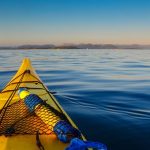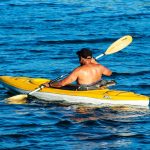How much time does it take to become a proficient windsurfer?
Although you can learn the basics of windsurfing in a day, it takes most people 3-5 years to become skilled at the sport. This can vary depending on the local conditions, windsurfing gear, and how often you practice.
The table below shows how long it takes to reach certain windsurfing skill tiers.
In the subsequent sections, we will analyze the following aspects of how long it takes to windsurf at each skill tier:
- Average Timeframe
- Reasons Why This Timeframe is the Norm
- Skills You Can Expect to Learn Within This Timeframe
- Conditions You Can Expect to Handle After This Time Commitment
- How Fast You Can Expect to Go At This Stage
How Long It Takes to Learn the Windsurfing Basics
The average person will only care about how long it takes to become a basic or intermediate windsurfer. However, it is good to have goals and know how much work it takes to become a professional windsurfer.
Learning the windsurfing basics takes approximately one day.
Most people can learn the basics of windsurfing in a day, as they are not usually looking to push the sport to its limits.
Most beginners choose to learn from a windsurfing instructor so they can learn the basics properly and prevent themselves from developing bad habits.
Due to the fact that the windsurfing gear is built with beginners in mind, people are able to focus less on balancing and more on enjoying the lesson.
With the modern, lightweight equipment that is available now, it is not as difficult as you might think to get started with windsurfing.
This is also true when learning how to snow ski. It is easy to learn the basics, but it takes much more time and practice to master the more difficult techniques.
Learn How to Windsurf – From Zero to Planing Hero
This blog is assuming that “learning how to windsurf” means being able to control the sails and the board in the harness, using both foot straps. Being able to stay upwind and complete most of your tacks and gybes is essential to progressing quickly.
I will begin your first lesson by discussing my quick method to planning in foot straps and making you feel great.
Beginner Stage – Learning the Basics
If you want to learn how to windsurf, I recommend taking a full beginner course. I’ve met many people who have taught themselves how to windsurf, but they usually have one or two bad habits that prevent them from getting better.
Although they are practicing, the skills of those who refuse to take beginner’s courses are not improving. It may feel like you’re saving money by not taking a course, but trust me, everybody benefits from starting at the beginning.
Developing a solid stance early on, understanding how the wind affects the rig and how to effectively counterbalance the rig’s forces are all much more difficult to learn in stronger winds on a more advanced kit. Also, bad habits are invariably hard to break!
Beginner’s Course: What to Look For?
If you want to take a beginner or start windsurfing course, it is a good idea to book it with an insured school that uses professionally trained instructors. The main governing body for windsurfing in the UK is the RYA (Royal Yachting Association), and most good instructors will have been trained under their scheme.
Another organization called AALA (Adventure Activity Licensing Authority) approves providers to be allowed to teach children under 18 without their parents present. This accreditation also indicates a high set standard of safety, kit, and tuition.
Slow, but Steady – Rya Courses
The texts states that RYA courses are typically longer, more in-depth, and based strictly around the RYA syllabus. It also states that on days when it is not possible to go on the water to windsurf, the courses usually involve sitting in a classroom and talking about high and low-pressure weather systems.
The Flexible Choice: Non-rya Courses
However, most non-RYA centers teach windsurfing in half the time by covering more in each session, spending less or no time in the classroom, and rescheduling courses in the event of bad weather. This accelerates how quickly people learn to windsurf!
I have taught RYA courses before where the whole first day was spent balancing sails on land and playing balance games on a board with no sail. This may help some people who learn very slowly or like to have their hand held every step of the way, but for the average person, this can seem tedious and a waste of time and money!
We offer our beginners windsurfing course in two, three-hour sessions which we suggest doing on different days within a week or so of each other, so you have time to rest in between but still retain the information from your first lesson.
We can set different exercises for people of different abilities in the same lesson so that everyone can progress without waiting for the whole group to learn a new skill. If the weather is not ideal for sailing, I’ll call you and reschedule the lesson.
The Worst Choice
I see three options when you learn how to windsurf. The third option is where you’re given the equipment and some vague instructions, told “you’ll be fine it’s easy,” and sent out onto a busy stretch of water with no idea what you’re doing and no buoyancy aid.
This is unsafe and gives all instructors a bad name.
Skills You Can Expect to Learn After One Day of Windsurfing
You can’t expect to learn more than the basics of a sport in just one day.
You will be able to identify the essential pieces of windsurfing gear after one day. This includes the mast, sail, boom, uphaul, and fin. Being able to identify this gear is a valuable skill that beginners commonly overlook.
You will learn how to transport the windsurfing gear out to the water safely to minimize the potential risk of injury as the majority of beginner windsurfing injuries occur at the shore break.
The following text is about what you can expect to learn while windsurfing. You will learn how to properly use the uphaul to bring the sail up, how to position your body, and how to harness the power of the wind.
Your instructor will teach you how to stop safely before you attempt to get going. Once you learn all of these prerequisite skills, you will be able to apply your newfound knowledge to windsurfing on the water!
If this seems like a lot of skills to learn in a short amount of time, you may be surprised at how much you can accomplish in one day with an instructor available to answer any questions and offer assistance.
A good beginner’s course should help you to be able to sail upwind by the end, or at least tell you what you need to do to be able to get there.
Being able to sail upwind is essential for both your safety and being able to improve, and if you can’t do it you won’t be able to progress.
I recommend practicing sailing upwind for at least 10 hours over a few weeks so you can get comfortable on the board and build up muscle memory of your existing skills before learning anything new.
Conditions You Can Expect to Handle
If you have only one day of windsurfing experience, you will be able to handle only the lightest wind and water conditions. These conditions include flat water with no or very few waves, and a large area of open water.
The best conditions for a novice windsurfer are 7-9 mph winds, although you can still do it with as little as 3 mph winds. Anything over 13 mph will be too much for a beginner.
How Fast You Can Expect to Go
Although everybody wants to test their speed limits as soon as they hop onto the windsurf board, it is unlikely that you will manage to break 13 knots without learning how to plane properly.
For those of you who do not know, planning refers to the ability of windsurfers to skim on the top of the water to reduce water drag and move at high speeds.
The most likely windsurfing techniques you will stick to are those that do not require planning, and move at speeds below 15 miles per hour.
How Long Until Intermediate Windsurfing Level
It takes intermediate windsurfers 6 to 12 months to improve their skills.
If it only takes a day to learn the windsurfing basics, why does it take so much longer to become intermediate?
Is it really only one day of instruction to get physically up on the windsurf board? If you’re sufficient at windsurfing at the intermediate level, does that mean you don’t need instruction?




